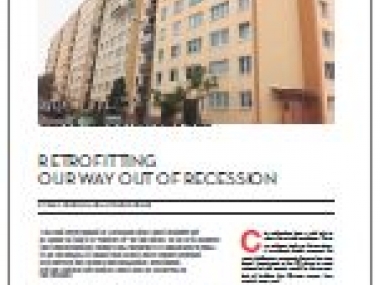Retrofitting Our Way Out of recession
Edited on
09 February 2015The built environment of European cities must urgently get in-shape so that it is "energy-fit" for the future. In order to achieve this transformation, owners and occupiers of buildings will need to be persuaded to make their assets more energy efficient. The URBACT "Building Energy Efficiency in European Cities" workstream has been set up to examine the role of city public authorities for energy efficient urban communities through retrofitting in the building sector. The article "![]() Download The Urbact Tribune Article Retrofitting our way out of recessionThematic Paper (429.81 KB)" written by Paul Ciniglio, Sustainability Strategist and Antonio Borghi, Lead Expert of the URBACT LINKS Project presents the first findings of their work.
Download The Urbact Tribune Article Retrofitting our way out of recessionThematic Paper (429.81 KB)" written by Paul Ciniglio, Sustainability Strategist and Antonio Borghi, Lead Expert of the URBACT LINKS Project presents the first findings of their work.

City authorities have a vital role to play in the retrofit revolution. This is no ordinary task; on the contrary, it is without doubt amongst the most challenging prospects Europe has ever faced. According to Antonio Borghi and Paul Ciniglio, investment in the UK alone to meet national retrofit targets would be the equivalent of building the Olympic games from scratch every year.
A strong and sustainable case exists for retrofitting our existing buildings in preference to their demolition and redevelopment. European policy on retrofitting continues to mature and coherent action must now follow. Despite the most difficult times of austerity, the economic benefits of mass retrofitting could be the best opportunity to pull the EU out of recession.
This interesting article primarily focuses on four interwoven catalysts for change.
- The first is to stimulate demand for retrofit by improving its appeal to building owners. This offer must be attractive and ideally made at a time to match demand for refurbishment work.
- The second is the need to seriously address fuel poverty and provide affordable warmth to millions of households in the face of rising energy supply prices and static levels of household income.
- The third is ensuring that adequate long-term and affordable sustainable finance is in place whilst simultaneously tackling user behaviour as an essential aspect of making the financing work.
- The fourth issue focuses on our unique urban heritage and the improvement of its energy efficiency. Historic buildings have specific peculiarities arising from their form and construction which relate to their value as material evidence of the past.
The Authors explain that "It is clear that the retrofit agenda demands that Europe looks back in time as its built environment if we are to create the cities of tomorrow". And their conclude "Let the retrofit revolution begin!"
Read more:
 Download The Urbact Tribune Article Retrofitting our way out of recessionThematic Paper (429.81 KB) - PDF
Download The Urbact Tribune Article Retrofitting our way out of recessionThematic Paper (429.81 KB) - PDF Download The Tribune 2012 (6.81 MB) - PDF
Download The Tribune 2012 (6.81 MB) - PDF
Submitted by admin on
